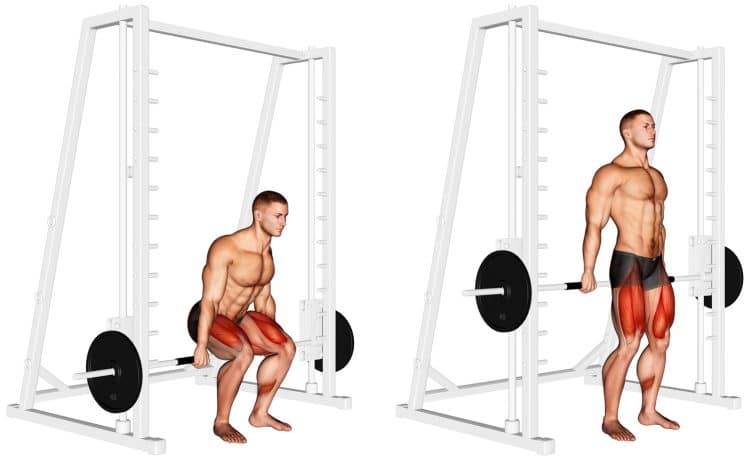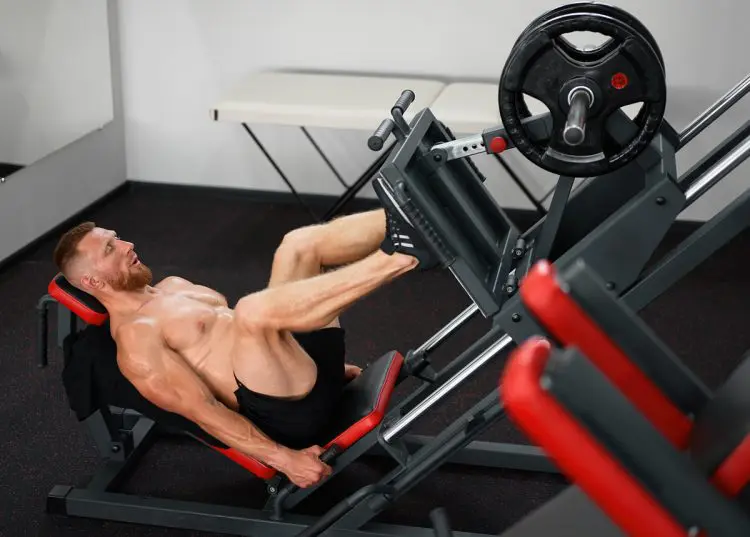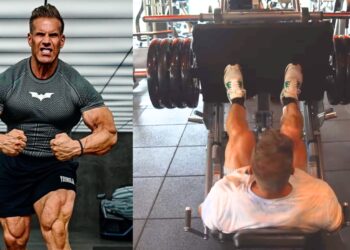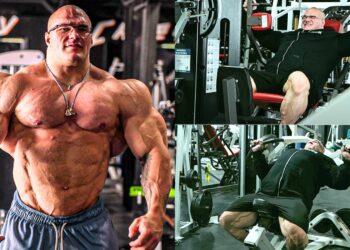Abbreviated from the name of its inventor George Hackenschmidt – Estonian Strongman and wrestling champion from the early 20th century – the hack squat and its variations have stood the test of time as being some of the best leg training methods to date. After all, take a look around at your local gym, and most of those machine contraptions having origins extending back decades and some even centuries.
While modern dedicated Hack squat machines are the best iterations of the popular exercise, the Smith machine hack squat is an excellent alternative that we can vouch for.
In this guide, we’ll talk about the benefits of Smith hack squats, and offer you the best training tips, variations, and more.
How To Do Smith Machine Hack Squats
If you don’t have access to a Hack squat machine or you prefer to closer mimic an upright barbell back squat, Smith machine hack squats are what we’d do instead. Below we’ve included a step-by-step breakdown of proper machine hack squat form with a video demonstration.
Step 1: Determining the type of Smith machine
When setting up on a Smith machine it’s important to know if it has straight/vertical or angled rails. If it has straight rails then you don’t need to worry. However, if the rails are at an angle then you should position yourself so that as you squat down, the bar moves slightly forward following the same angled path as a hack squat. Then as you stand up out of the squat, you’ll move slightly backward.
Now you’re ready to set up for the squat.
Level Up Your Fitness: Join our 💪 strong community in Fitness Volt Newsletter. Get daily inspiration, expert-backed workouts, nutrition tips, the latest in strength sports, and the support you need to reach your goals. Subscribe for free!
Step 2: Finding the right bar height
The first thing you want to do especially before adding weight is place the Smith machine bar at the right height so that you can un-rack it in an efficient manner. That means not too high and not too low. The bar should be roughly at upper chest/lower delts level. Then you can hook the bar in position near the top portion of the squat but leave enough room to where you can un-rack the bar and untwist the hooks from the pegs without having to raise up on your toes.
Face in the direction that will allow you to rotate your wrists forward after un-racking the bar.
Pro tip: You should be able to un-rack the bar from a high/quarter squat position so that you can comfortably lift it off the pegs without having to use too much energy or having to lift your heels to push the bar up and twist the safety hooks back.
Step 3: Form and body position
This is where the Smith hack squat differs from a normal Smith machine squat.
- Grab the bar evenly on both sides palms facing forward, dip underneath it and position yourself so that the bar is sitting on the middle portion of your trapezius muscles in a comfortable spot, not too high or low. Tense your core muscles hard then drive through your midfoot and heels to lift the bar up and twist the hooks off the pegs. Move your feet forward about 1-1.5 feet in front of you and assume a roughly hip width stance. For this variation, most people point their toes straight forward as the feet should be closer together compared to a normal squat. You want to keep your head up and eyes looking forward.
Step 4: Squat!
Now you’re ready to perform Smith machine hack squats.
- Sit your butt down toward the heels by bending your hips and knees until your legs are slightly below or roughly 90 degrees. Push your feet down into the floor until you’re standing straight up in the starting position. Repeat for the desired number of repetitions.
Check out the following video tutorial for a demonstration and explanation of proper Smith machine hack squat form and execution.
Common Mistakes
It’s too easy to make form mistakes when it comes to the Smith machine hack squat.
Feet too close to your body
Keeping your feet too close to your body would just make it a regular squat. To truly get the benefits from a hack squat, the body and feet need to be positioned accordingly. We recommend moving your feet 1-1.5 feet in front of you, and it’s okay to play with your footing a little to find what works best for you.
Feet too far forward
While the feet need to be out in front, you don’t want them to be too far away from your body. Otherwise, you’re not going to be able to squat properly.
Not keeping your feet in the same spot
Sort of tying the previous points together, ensuring that your feet are in the same spot for each set is especially more important for the Smith Hack squat. With a freeweight barbell squat, your feet must remain under your body close to your center of gravity or you just won’t be able to squat safely and effectively. In other words, your feet do not get to pick their spot as is possible with Smith squats. And with that comes a responsibility to ensure consistency.
Having your feet off even just an inch can make a big difference in how you squat on the Smith machine. We recommend placing something on the floor to keep your feet in the exact same spot every time.
Smith Machine Hack Squat Benefits
Why should you choose to include Smith machine hack squats in your leg workouts?
Better than freeweight back squat…
Don’t let anyone make you feel like freeweight exercises are the only way to make gains. Sure, they’re a necessary component of a well-rounded fitness regime and have their advantages, but they’re not always the best option. Many times taller lifters will shift their hips too far back and as a result, they’ll feel the freeweight barbell back squat more in their lower back and less on their quads. It becomes more of a good morning than a squat.
Being able to position your feet out in front of your body during a Smith squat can be a gamechanger for these individuals because it allows them to remain more upright in a more comfortable and ergonomic angle for their bodies.
No balancing a bar
Free weight squats require an additional level of focus to keep the bar in place, and evenly balanced whereas machines don’t which makes it such an attractive option. The bar is fixed and pre-balanced so that all you need to do is load and go!
Prevent training boredom
While some people are perfectly content with doing the same type of exercise every session, most of us prefer a little variety to make training more palatable as burnout is a real thing sometimes. Trying out new techniques is also a great way to experiment with different body angles and many times, we find something that works better. But with all that being said, we do recommend this exercise for those with some training experience.
Drawbacks
So why do Smith machine squats oftentimes get a bad rap?
Uses less muscular stabilization
Freeweight movements are often considered superior to other forms of exercise overall because they require heavy use of stabilizer muscles. This is believed to result in better overall development and yeah there’s probably some truth to that (1). However, when it comes to hitting the primary muscle groups (e.g., pectoralis major, gluteus maximus), machines will allow you to lift heavy and stimulate those areas for max gains. In one study where volunteers performed both variations for comparison, the Smith machine squat one-rep max lift was higher than that tested by the freeweight squat due to less stabilizer requirements (2).
Level Up Your Fitness: Join our 💪 strong community in Fitness Volt Newsletter. Get daily inspiration, expert-backed workouts, nutrition tips, the latest in strength sports, and the support you need to reach your goals. Subscribe for free!
Smith hacks may not allow you to lift as much weight compared to a conventional Smith squat but you get the idea.
Fixed movement
Both a pro and con depending on who you ask. Some people are totally against Smith machine squats while it’s a saving grace for others. Being restricted in your movement means you have to adjust to the design of the machine but then again, it’s nice to be locked in where you can rely on a machine to hold you in place.
But when it comes to functional strength development, freeweight squats win hands down. That’s because with machine exercises you’re missing the raw nature of a compound, multi-joint lift. You can get great results by incorporating both.
Not as ergonomic like a Hack squat station
Replicating a hack squat on the Smith machine is going to be different than doing it using dedicated Hack squat equipment. A Hack station is setup so that you can do a fully reclined squat and is, therefore, designed specifically for that whereas a Smith machine bar moves vertically or at a slight angle and there’s no backrest, foot plate, or padded shoulder arms.
Smith Machine Hack Squat Variations
These are exercises that can replace the Smith hack squat.
1. Hack squat machine
The hack squat machine is a great piece of equipment made specifically for this exercise, and consequently, it’s going to be the best hack squat variation, even over the Smith machine version. That’s because it’s an angled machine with a built in foot platform, full body padded backrest and shoulder arms that allow you to place your arms in front of your body in a more comfortable position.
It’s an excellent implement for loading with a lot of weight and blasting your lower body.
2. Reverse hack squat
For every gym rat who loves to lie face up on the hack squat machine and stare at the mirror (nothing wrong with that), there are those who prefer to face the machine. It’s more like a conventional squat position.
To do it:
- Stand with your heels on the bottom part of the platform and your toes on the floor pointed slightly outward.
- Lean forward into the machine so that your shoulders are underneath and at the edge of the padded arms. Grab onto the handles for support. Do not press your chest and hips into the machine but rather keep your butt back and torso leaned slightly forward as you normally would during a squat.
- Drop your butt straight down into a squat and then push into the platform using your heels to stand back up in the starting position.
Check out this explanation and demonstration of the reverse hack squat by legendary trainer Charles Glass. Bonus: Try stiff-legged deadlifts on the hack squat as also shown in the video example below.
3. Barbell hack squat
While more awkward than the Smith machine hack squat, the barbell hack squat is the perfect choice for when you don’t have access to a machine or you like challenges. It’s actually more like a deadlift but while holding the bar behind your back (backloaded deadlift) and your quads will get absolutely torched with this variation.
4. Belt squat
If you want to replicate a loaded upright squat without the weight resting on your upper back and loading the spine then the underrated belt squat is a movement you should consider. And more like the hack squat, your feet can be positioned in front of your body.
A dipping style belt is worn around the waist and attached to the loaded floor squat implement. These machines typically come with some sort of handles for support.
5. Leg press
Leg presses are similar to a hack squat in some ways especially because your back is supported through the movement. Therefore, while both do engage the core muscles, it’s not to the same degree they would during a freeweight variation.
But that’s also advantageous because these types of exercises focus on building pure strength and consequently, heaps of muscle growth.
6. Smith machine squat
Some people may prefer the Smith machine version of a freeweight barbell squat and it’s become a staple for many serious lifters. Smith machine squats come with many advantages over its freeweight counterpart including being locked in place, safety, and the ability to use various foot positions.
Programming Smith Machine Hack Squats
Whether you want to train heavy or high rep you can do either using the Smith machine hack squat variation just as you would on a specialized hack squat machine. Also, as previously mentioned, the Smith hack squat may be a better setup for certain lifters than a normal Smith squat where the feet are closer to your center of gravity. Therefore, it can be the primary Smith squat technique that you use if it works better for you.
With that being said, the Smith hack squat can replace freeweight squats, although you should make sure to include other freeweight leg exercises in your workouts.
Sets and Reps
Many would agree that the lower body responds better to higher rep training than the upper body muscles. Therefore, we’ve included some sets and reps suggestions based on real world feedback.
- Strength: 3-5 sets x 4-6 reps
- Hypertrophy: 2-4 sets x 6-25 reps
- Muscle endurance: 2 sets x 25+ reps
Muscles Worked
Squats are a full-body exercise period! You’ll work almost every major muscle group and below we’ve included their anatomy, function, and the benefits of training them

- Gluteus Maximus – Gluteus maximus is the largest and most superficial muscle that makes up the majority of the size, shape, and appearance of the butt and hip muscles. It’s a prominent functional and aesthetic muscle group. The butt primarily extends and externally rotates the thighs and it plays an important role in helping us to maintain an upright posture.
- Quadriceps – The quadriceps or quads for short is the large group of muscles that make up most of your upper leg mass. It has four heads; rectus femoris, vastus lateralis, vastus medialis, and vastus intermedialis. These muscles help to flex the hips and extend the knees during movements such as squats. They’re also important for posture, walking, and the function of the spine and pelvis.
- Hamstrings – The hamstrings is a three-headed muscle group consisting of semitendinosus, semimembranosus, and biceps femoris. Located on the back of the upper leg opposite the quads, they function to extend the hips and flex the knees. The short head of the biceps femoris only crosses the knee joint and not the hip like the other two muscles.
- Adductor magnus – The adductor magnus is the largest of the muscles that make up the adductor group of muscles in the medial compartment of the thigh. While it assists during adduction of the thigh (limb moves toward the center of the body), the adductor magnus also helps with hip extension and medial rotation. It has anterior and posterior fibers that help it act on the front and back of the leg.
- Calves – The calves make up the lower leg muscles below the knee. They function to point the toes down and are athletic muscles. All compound leg exercises involve the calves.
- Core/abs – The core consists of several muscles – abs (curls the pelvis and rib cage toward each other), obliques (located on either side of the abs and rotate the torso), deeper core muscles (transverse abdominis and internal obliques draw the belly button to the spine and stabilize the trunk), back extensors (allow us to stand up straight from a bent-over position and lean backward).
Frequently Asked Questions
Why is it called hack squat?
The hack squat is generally credited to the likes of Estonian strength sports pioneer and Heavyweight wrestling champion Georg Hackenschmidt (hence the moniker) who is also said to have popularized the bench press.
How Much Does A Smith Machine Bar Weigh?
While it’s not exactly relevant as long as the bar supports your workouts, most, if not all gym bros and gals have at some point wondered how much a Smith bar weighs compared to the common 20 kilograms or 44 pounds freeweight bench press barbell.
Smith machines typically weigh anywhere between 7-30 pounds depending on the variation. Learn more about Smith Machine bar weights here.
Bottom Line
We’d never tell you to replace a conventional freeweight barbell squat with any variation let alone one using a Smith machine. But the Smith hack squat is one of the best ways to spice up your leg training and tap into a level of challenging mind-muscle focus that you’re probably not used to. It’s a variation of the basic Smith squat that offers many advantages over leg movements, and you’ll likely see some gains from adding it to your workouts.
Interested in measuring your progress? Check out our strength standards for Good Morning, Smith Machine Squat, Hack Squat, and more.









